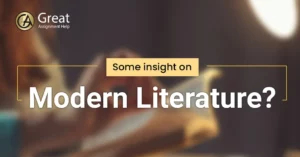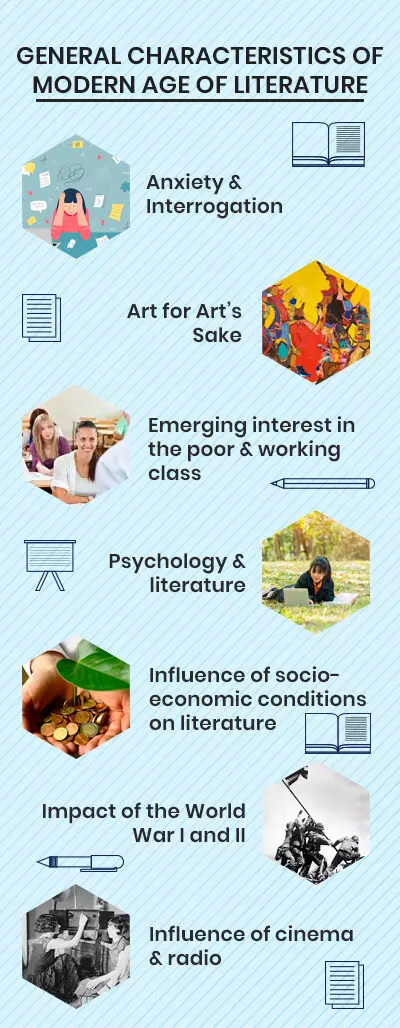Modern literature reflects the world we live in today. It is diverse and focuses on different voices and ideas. Contemporary authors explore new themes and styles and create a rich and dynamic literary landscape. This makes them develop a thrilling literary scene that is full of creativity and innovation.
Literature is a collection of written work in the form of prose or verse. Literature expresses the feelings, emotions, and thoughts of people through poems, dramas, etc. English literature is one of the popular pieces of literature that refers to various pieces of text around the world that are written in the English language. With the advent of industrialization and advancements in social science, modernism got a new shape. Modernism was a literary revolution. The modern period in English literature began in the late 19th and early 20th centuries. The prominent feature of modern English literature opposed the common attitude towards the life portrayed in Victorian literature. If you wish to learn more about the modern age of English literature, then continue reading this blog post.
What is Modern Literature?
Modern Literature is literature that is written during the contemporary period. In Britain, the modern period began in 1901 with the end of the Victorian era and literature. Modernism is a branch of modern literature that deviated from the realist novels that were more dominant in the Victorian Era. It was a kind of literary movement that presented a disregard for conventions and various other forms. This, in turn, finally led to fascism and narcissism.

The 20th century is a period during which people experienced enormous advancements in both natural and social sciences. Mainly, because of this rapid progress, great profit was shown in material wealth. However, the entire scenario changed when capitalism came into the limelight. The economic conditions were affected because of the contradictions between social and private ownership. Even because of World War I and World War II, more chaos was seen in society and literature. The modern period in English literature likely defines anti-war opinions and reflects thoughts on science and psychology to show the effect of colonialism.
To know more about the modern age of English literature, it is necessary to know the information present during Victorian literature. When the Victorian age came to an end, writers felt the need for changes in the modes of literature. Predominantly, science and arts influence modern English literature.
Read More – How to Write an Ideal Literature Review? Find the Essential Tips
Common Characteristics of the Modern Age of Literature
Anxiety and interrogation
The 20th century has also been named the age of anxiety and interrogation. In this era, people’s faith in religion and beliefs. Also, the rapid changes found in moral, social, moral, economic, and political scenarios. Furthermore, reflecting rational thinking means freedom of thought and actions.
Art for Life’s Sake
So, in this age of literature, the doctrine of art for art’s sake was rejected, whereas art for life’s sake was recognized. Also, it unveils the role of realism that focuses on the issues of real life. Hence, the efforts of writers Shaw, H.G. Wells, and Kipling are unforgettable in this era.
Developing an interest in people belonging to the lower-income and working classes
Well, the early phase of the 20th century ended the predominance of middle-class people. Additionally, it also posed a great challenge to social conscience and was reflected in drama. Therefore, it is the age in which people’s interests bend towards the lower-income and working classes.
Psychology and literature
Thus, new psychology research influenced modern literature. In this period, the rational view of sex relations is discussed. This new age describes the rationalization of emotional needs and sexual behavior.
Repercussions of Social and Economic Situations in Literature
Undoubtedly, the modern age of literature shows the influence of social and economic changes. In the 20th century, modern literature reflects the changes brought by rapid industrial development on social conditions. Likewise, It shows the role of money in human relationships. And, writers have raised their voices against poverty and the influence of Marxism on literature.
Influence of the two World Wars
So, the modern age of literature shows the impact of the two World Wars. After world wars, depression, and unemployment emerged. Due to this, a large number of anti-war books were written reflecting the emptiness and futility of the war.
Impact of cinema and radio
Hence, Modern literature has shown the impact of cinema and radio. They boosted the connection of people with literature. Due to the invention of the locomotive, the telegraph, and inexpensive intercommunication, an intellectual revolution has resulted. So, this makes literature a part of human life.
Also Read: Learn How to Cheat on Apex Learning
Get to Know the Shift from the Victorian Age to the Modern Age
Now, there are some points that you need to read to understand the evaluation of the modern age. Also, many things have changed from the Victorian age to the modern age. Moreover, people can observe the changes in ideas, vision, and way of seeing social issues.
Changes in thoughts and emotions
Victorians were regarded as hypocritical, and their ideals as reckless and mean. They believe in the longevity of 19th-century institutions, both secular and spiritual. They never raised questions and thought that their family life, the British Empire, and religious values would last endlessly. Writers of the modern age raised questions on everything and know that things will change. Their values are not limited to family members, as they reflect the prominence of sex in relationships. Thus, modernism in literature seeks a fresh vision to look at different things with fresh techniques.
Age of Machine
Without any doubt, machinery influences the modern age and people’s lives. Mix response over the influence of the modern age shared by the readers and writers. They also show the indications of materialism in people’s lives as a result of machinery consequences. The advent of machinery raises the standard of living and confers untold blessings on humans. But, at the same time, it also increased stress and tensions. In the 20th century, the activities of humans were not controlled by their moods and impulses; they followed the time and worked under a definite schedule.
Influence the people of the poor classes
Modern literature influences the poor class people who were educated by the state. For them, publishers reprinted the complete series of their publications in a very affordable range. Modern literature is full of adventures and experiments, and acts as an age of discovery and transition. It shows the new ideas of the modern man’s mind.
Read more: Literary Research Topics – To Gauge the Literature
Understand the History of English Modern Literature
1. Literary movements
The end of the First World War has raised all kinds of literary movements or trends. Some of them are cubism, futurism, surrealism, expressionism, surrealism, symbolism, imagism, a stream of consciousness, and Dadaism. Let’s understand its impact on a different form of literature:
2. Modern poetry
Modern English poetry has shown opposition to Victorianism. It reflects the revolution against conservative thoughts. The modern age of English literature also affects the art of modern poetry. Writers’ thoughts and technological changes are also visible in modern poems and dramas. Some features of modern poetry are discussed below:
- It shows the opposition to romantic and Victorian poetry.
- It doesn’t support religious faith and the disappearance of the writer’s imagination.
- Modern poetry doesn’t reflect regular rhyming patterns.
- Writers show the juxtaposition of thoughts.
- It uses irony, metaphors, and free verse.
For getting the instances of modernization, read the poem “The Waste Land” by T.S. Eliot. It reflects movements totally against romanticism and Victorianism. Here, you have to understand the movements in modern poetry, Imagism, and Symbolism:
Imagism: This literary movement started in the early 20th century and was active for 10 years. In this movement, the imagists rejected the emotions of Victorian and romantic poetry. Instead of decorative words, they use exact words and define thoughts in a common language. Ezra Pound was the leader of the imagists.
Symbolism: It first began in France and described things with the help of symbols. The beauty of day-to-day life was also expressed by the symbolists. Their creation is not limited to any specific topic, concern, or rhythm. After the publication of the poem “The Waste Land,” the symbolists’ poetry came into existence.

3. Modern novels
For modern novels, the starting three decades of the 20th century were remembered as the golden years. The technique of stream of consciousness became the best technique for novelists in the 20th century. Modern man prefers to read a novel as it describes the real experience. It is the only form of literature that meets the needs of the modern age. Some characteristics of modern novels are:
- It’s based on realism and opposes idealism.
- It follows Sigmund Freud’s theories that reflect the hidden inner motives of people’s actions.
- The modern English novel shows the development of psychology.
- It also unveils modern scientific discoveries and new technologies.
- The 20th-century novelists consider the stream of consciousness as the best technique to express their ideas.
4. Modern English drama
Now, the two most famous dramatists at the end of the 19th century were Oscar Wilde and George Bernard Shaw. They also kept the foundation of modern dramas.
Key Elements of Modern Literature
To make the works of the modernists stand unique in the crowd, the essential elements of modernism play a key role. Here, let us, look at the important elements of modern literature that matter the most.
Individualism
Modernism’s primary component is individualism. On the whole, it contends that an individual’s experiences, ideas, and feelings are more interesting than societal events. Therefore, modernism is more concerned with portraying the subjective reality of an individual than it is with societal shifts or impersonal historical occurrences.
In modernist literature, the protagonist typically merely tries to live and adjust to a changing environment. When faced with challenges, the protagonist doesn’t always give up. Strong instances of individualism can be found in Ernest Hemingway’s writing.
Fictional narrators became untrustworthy due to their obsession with subjective reality. Franz Kafka’s works contain some excellent examples of the Madman variety of unreliable narrators.
Absurdity
Authors of the modernist era observed as their familiar world fell apart around them. The two World Wars, the emergence of capitalism, and the rapid pace of globalization all weakened the beliefs and perspectives that writers had about humanity.
Many of them were prompted by this to write about how ridiculous they thought the world was. Based on this feature, modernist works take surrealist or fantastical turns in everything from the setting to the story progression. Another way to characterize them would be as absurd or strange.
The Theatre of the Absurd was created as a result of the growth of absurdism. It is centered on the notion that there is no greater meaning or purpose to human existence, and it was invented by European playwrights. Rather than aiming for good communication, absurdist comedies use illogical speech. Franz Kafka, particularly in The Metamorphosis, is the master of literary modernism when it comes to absurdity in literature.
Experimentation
Many of the established writing conventions were abandoned by literary modernism, opening the door for form experimentation. The best examples of it are modernist poets, who rebelled against the conventional sense of rhyme and rhythm, giving rise to free verse, or vers libre.
Prose experiments were also influenced by modernism in literature. In addition to individualism as a fundamental quality, writers created a storytelling technique known as “stream of consciousness.”
This device may be erratic, disorganized, or nonsensical, but it is intended to represent the characters’ thought processes. Authors are now able to create novels that read like the protagonist’s stream of consciousness thanks to this innovative technology. James Joyce and Virginia Woolf are two of the best writers who exemplify this quality. T. S. Eliot and Ezra Pound’s poetry collections are essential reading.
Symbolism
Although symbolism in literature predates the late 19th century, it swiftly rose to prominence as a key element of modernism in literature. Symbolism was also reinterpreted by modernist poets and writers. Modernists sought to leave plenty of space for the reader’s imagination to fill, in contrast to their predecessors who left little unsaid.
That does not imply, however, that no attention to detail was paid. Conversely, modernist writers included symbolic nuances at every level of their literature. The distinction is in the way they employed symbolism in their writing, which permitted multiple interpretations that were all concurrently plausible and legitimate.
The modernist literary movement’s symbolism is particularly noticeable in the writings of T. S. Eliot and James Joyce.
Formalism
As previously said, 20th-century modernism was defined by the search for fundamentally new modes of expression. Creativity spurred this search, allowing for the birth of unique shapes.
In the modern period of literature, writing was no longer regarded as a difficult craft. Modernists viewed it as a creative process. In certain cases, the novelty of the form was valued more than the substance.
Consider the works of E.E. Cummings as an example. Instead of writing the poetry on the page in the traditional manner, he spread out individual words and phrases across the page as if it were a canvas with his poem as the paint. Other instances of formalism are the use of invented or foreign words and phrases, and unorthodox organization.
Artistic Characteristics of Modern Literature
Modernism
Modernism shows the scientific and technological revolution in the writer’s thoughts. It defines people’s emotions and problems in a more real way. Furthermore, it is divided into two categories realism and radicalism. Well, the modern age of English literature was initiated at the early start of the 20th century and at the end of the Victorian age. Its fundamentals show contractions of the Victorians’ perspectives.
Basic features of modernism
- It shows a strong barrier to traditional values against political, social, and religious views.
- In modernism, all things are relative, as no such thing defines absolute truth.
- The most prominent characteristic of modernism is celebrating the inner strength to appreciate the championship of the individual. Well, four literary ‘isms’ that express this inner strength are subjectivism, impressionism, expressionism, and surrealism.
- According to modernism, life is unordered.
- It doesn’t show any connection with history or institutions. It originated from the corruption and frustrations of people after the war.
List of Prominent Contributors to Modern Literature
- Novelist John Galsworthy (14 August 1867- 31 January 1933)
- Playwright George Bernard Shaw (26 July 1856 – 2 November 1950)
- Irish novelist James Joyce (2 February 1882 -13 January 1941)
- Poet Thomas Stearns Eliot (26 September 1888 – 4 January 1965)
- Writer David Herbert Lawrence (11 September 1885 – 2 March 1930)
- Irish Poet William Butler Yeats (13 June 1865 – 28 January 1939)
Well, to understand the evolution of English literature, you need to go through the work of famous poets and writers. Thus, their work helps you to understand visions and thoughts, demonstrating the changes in society. For a better understanding, let’s discuss the work of D. H. Lawrence.
Writer David Herbert Lawrence (11 September 1885 – 2 March 1930)
He was born in a mining village in Nottinghamshire. And, his father didn’t have a great educational background, but his mother was once a schoolteacher.
So, his major work in the field of literature:
- Women in Love
- The Rainbow
- Lady Chatterley’s Lover
Some facts about D. H. Lawrence
- His writing expressed a reaction against the mechanical civilization. According to him, bourgeois industrialization or civilization has adverse effects on the relationship between man and the environment.
- He felt that the mechanical world controls people. Hence, they become the source of something that could destroy both humankind and the Earth.
- His masterpiece “Son and Lovers” is an autobiographical novel. It reveals the strong connection of an ambitious woman with coal miner Walter Morel.
- He was the first novelist who introduce psychology in his work. Also, he described the psychological experience of human life and human relationships.
- Lawrence’s work shares realism with the combined effect of dramatic scenes and authoritative commentary. Also, his writings beautifully described the simplicity and directness of working-class people.
Conclusion
So far, in this blog, we have seen the various aspects of modern English literature. Typically, modern literature uncovers the vision of different literary writers and poets. Furthermore, the works of modernist writers will be more realistic and portray the numerous ways of living and the social culture of people. In case you are curious to know more about modernism in literature, you may approach the literature experts from our team. From pre-modern literature to modern literature, our professionals will guide you in expanding your knowledge in this regard.



